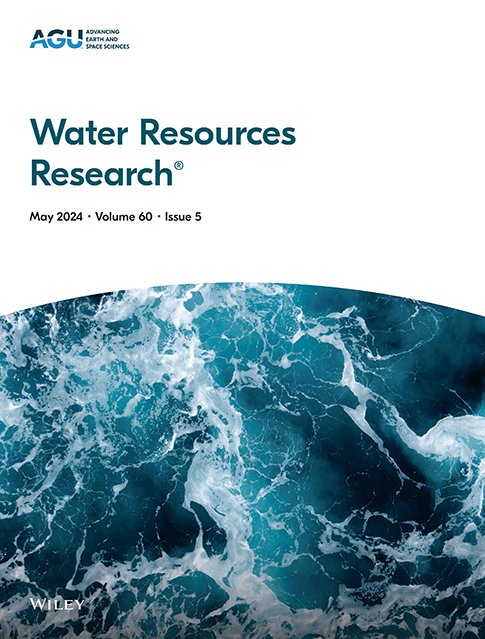Cascaded Machine Learning of Soil Moisture and Salinity Prediction in Estuarine Wetlands Based on In Situ Internet of Things Monitoring
IF 4.6
1区 地球科学
Q2 ENVIRONMENTAL SCIENCES
引用次数: 0
Abstract
Estuarine wetlands, formed by the interaction of fluvial and tidal processes, exhibit complex spatiotemporal variations in soil moisture and salinity. Predicting soil moisture and salinity in estuarine wetlands is key for ecosystem management and assessing environmental impacts, while traditional methods have limitations in resolution and complexity. The elucidation of transport pattern and prediction of water and salt in estuarine wetland soils remain significant challenges. To address these challenges and improve our ability to predict and manage wetland soil properties, this study employs an in situ Internet of Things (IoT)-based monitoring network and a interpretable, cascaded machine learning model to predict these critical soil parameters. The IoT platform facilitates real-time and longitudinal tracking of soil volumetric moisture content, salinity, and groundwater depth in the Yellow River Delta salt marsh wetlands, and the high-fidelity monitoring data are used to build a two-stage machine learning model. Artificial Neural Networks, Support Vector Machines, Random Forests (RF), and Gradient Boosting Decision Trees (GBDT) were used to develop the soil moisture and salinity prediction models. The cascaded framework, in combination with a moisture and a salinity sub-model, which inspired by soil water and salt transport processes, was found to be an effective approach for capturing moisture-salinity dynamics. The Gradient Boosting Decision Tree (GBDT) algorithm predicted moisture best (R2 = 0.846), while the GBDT-RF model predicted salinity best (R2 = 0.875). To enhance model interpretability, SHAP (Shapley Additive exPlanations) analysis was applied, revealing that groundwater depth is the most significant positive driver of soil moisture, while water content is the dominant negative driver of soil salinity. These findings align with established eco-hydrological processes, validating the models' ability to capture physically meaningful relationships. Sensitivity analysis revealed critical groundwater depth thresholds that strongly influence soil moisture and salinity. Specifically, as the water table rises, soil moisture increases to saturation at −0.5 m. Salt accumulates rapidly at −0.8 m (27% soil moisture) and becomes stable and close to seawater salinity. With real-time in situ monitoring and the cascaded soil property prediction model, the method framework can accurately simulate and predict wetland soil moisture and salinity patterns, providing a valuable tool for monitoring and managing these vulnerable ecosystems and better understanding of wetland responses to environmental changes and supports evidence-based conservation.基于现场物联网监测的河口湿地土壤湿度和盐度预测的级联机器学习
河口湿地是由河流和潮汐过程相互作用形成的,土壤水分和盐度呈现出复杂的时空变化。预测河口湿地的土壤水分和盐度是生态系统管理和评估环境影响的关键,而传统方法在分辨率和复杂性方面存在局限性。阐明河口湿地土壤中水和盐的迁移模式并进行预测仍然是一项重大挑战。为了应对这些挑战,提高我们预测和管理湿地土壤特性的能力,本研究采用了基于物联网(IoT)的原位监测网络和可解释的级联机器学习模型来预测这些关键的土壤参数。物联网平台有助于对黄河三角洲盐沼湿地的土壤容积含水量、盐度和地下水深度进行实时和纵向跟踪,并利用高保真监测数据建立两阶段机器学习模型。人工神经网络、支持向量机、随机森林(RF)和梯度提升决策树(GBDT)被用于开发土壤水分和盐度预测模型。研究发现,将级联框架与受土壤水分和盐分迁移过程启发的水分和盐分子模型相结合,是捕捉水分-盐分动态的有效方法。梯度提升决策树(GBDT)算法对水分的预测效果最好(R2 = 0.846),而 GBDT-RF 模型对盐度的预测效果最好(R2 = 0.875)。为了提高模型的可解释性,应用了 SHAP(Shapley Additive exPlanations)分析,结果显示地下水深度是土壤湿度最重要的正向驱动因素,而含水量则是土壤盐分的主要负向驱动因素。这些发现与既定的生态水文过程一致,验证了模型捕捉物理意义关系的能力。敏感性分析表明,地下水深度临界值对土壤水分和盐分有很大影响。具体来说,随着地下水位的上升,土壤水分在-0.5 米处达到饱和。盐分在-0.8 米处(土壤水分 27%)迅速积累,并变得稳定,接近海水盐度。通过实时原位监测和级联土壤性质预测模型,该方法框架可以准确模拟和预测湿地土壤湿度和盐度模式,为监测和管理这些脆弱的生态系统提供了宝贵的工具,并能更好地了解湿地对环境变化的响应,支持循证保护。
本文章由计算机程序翻译,如有差异,请以英文原文为准。
求助全文
约1分钟内获得全文
求助全文
来源期刊

Water Resources Research
环境科学-湖沼学
CiteScore
8.80
自引率
13.00%
发文量
599
审稿时长
3.5 months
期刊介绍:
Water Resources Research (WRR) is an interdisciplinary journal that focuses on hydrology and water resources. It publishes original research in the natural and social sciences of water. It emphasizes the role of water in the Earth system, including physical, chemical, biological, and ecological processes in water resources research and management, including social, policy, and public health implications. It encompasses observational, experimental, theoretical, analytical, numerical, and data-driven approaches that advance the science of water and its management. Submissions are evaluated for their novelty, accuracy, significance, and broader implications of the findings.
 求助内容:
求助内容: 应助结果提醒方式:
应助结果提醒方式:


